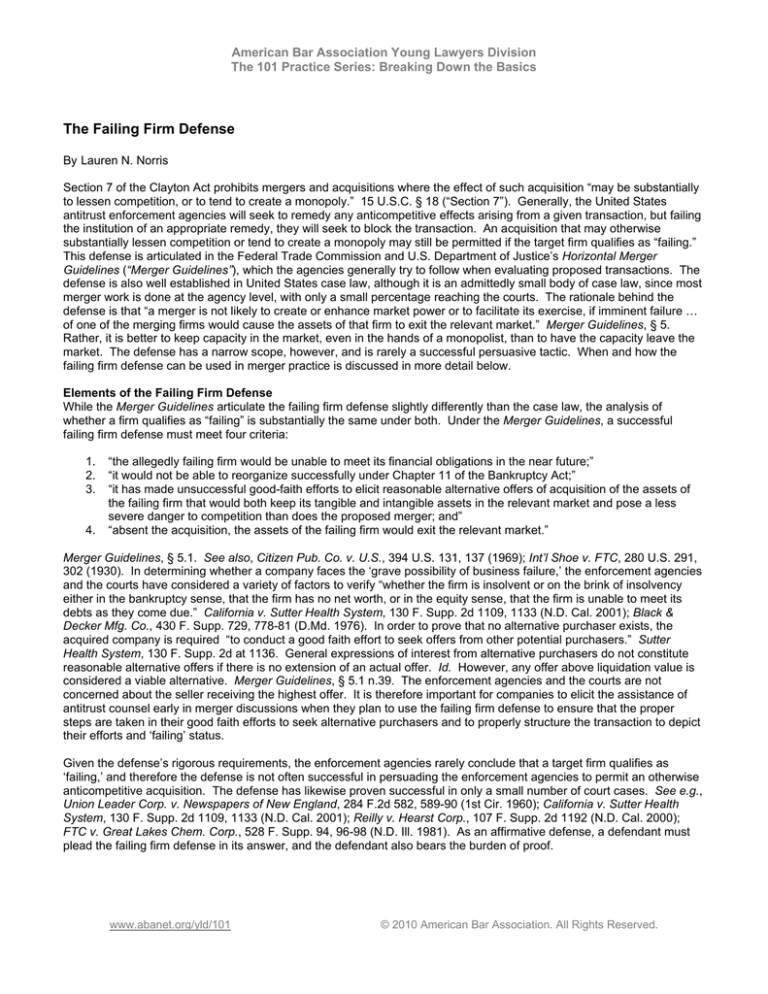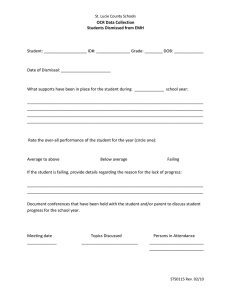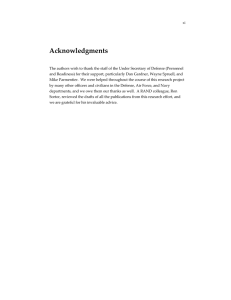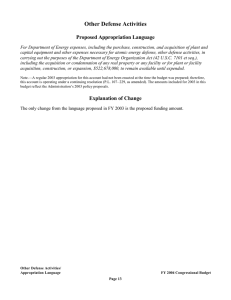
American Bar Association Young Lawyers Division
The 101 Practice Series: Breaking Down the Basics
The Failing Firm Defense
By Lauren N. Norris
Section 7 of the Clayton Act prohibits mergers and acquisitions where the effect of such acquisition “may be substantially
to lessen competition, or to tend to create a monopoly.” 15 U.S.C. § 18 (“Section 7”). Generally, the United States
antitrust enforcement agencies will seek to remedy any anticompetitive effects arising from a given transaction, but failing
the institution of an appropriate remedy, they will seek to block the transaction. An acquisition that may otherwise
substantially lessen competition or tend to create a monopoly may still be permitted if the target firm qualifies as “failing.”
This defense is articulated in the Federal Trade Commission and U.S. Department of Justice’s Horizontal Merger
Guidelines (“Merger Guidelines”), which the agencies generally try to follow when evaluating proposed transactions. The
defense is also well established in United States case law, although it is an admittedly small body of case law, since most
merger work is done at the agency level, with only a small percentage reaching the courts. The rationale behind the
defense is that “a merger is not likely to create or enhance market power or to facilitate its exercise, if imminent failure …
of one of the merging firms would cause the assets of that firm to exit the relevant market.” Merger Guidelines, § 5.
Rather, it is better to keep capacity in the market, even in the hands of a monopolist, than to have the capacity leave the
market. The defense has a narrow scope, however, and is rarely a successful persuasive tactic. When and how the
failing firm defense can be used in merger practice is discussed in more detail below.
Elements of the Failing Firm Defense
While the Merger Guidelines articulate the failing firm defense slightly differently than the case law, the analysis of
whether a firm qualifies as “failing” is substantially the same under both. Under the Merger Guidelines, a successful
failing firm defense must meet four criteria:
1.
2.
3.
4.
“the allegedly failing firm would be unable to meet its financial obligations in the near future;”
“it would not be able to reorganize successfully under Chapter 11 of the Bankruptcy Act;”
“it has made unsuccessful good-faith efforts to elicit reasonable alternative offers of acquisition of the assets of
the failing firm that would both keep its tangible and intangible assets in the relevant market and pose a less
severe danger to competition than does the proposed merger; and”
“absent the acquisition, the assets of the failing firm would exit the relevant market.”
Merger Guidelines, § 5.1. See also, Citizen Pub. Co. v. U.S., 394 U.S. 131, 137 (1969); Int’l Shoe v. FTC, 280 U.S. 291,
302 (1930). In determining whether a company faces the ‘grave possibility of business failure,’ the enforcement agencies
and the courts have considered a variety of factors to verify “whether the firm is insolvent or on the brink of insolvency
either in the bankruptcy sense, that the firm has no net worth, or in the equity sense, that the firm is unable to meet its
debts as they come due.” California v. Sutter Health System, 130 F. Supp. 2d 1109, 1133 (N.D. Cal. 2001); Black &
Decker Mfg. Co., 430 F. Supp. 729, 778-81 (D.Md. 1976). In order to prove that no alternative purchaser exists, the
acquired company is required “to conduct a good faith effort to seek offers from other potential purchasers.” Sutter
Health System, 130 F. Supp. 2d at 1136. General expressions of interest from alternative purchasers do not constitute
reasonable alternative offers if there is no extension of an actual offer. Id. However, any offer above liquidation value is
considered a viable alternative. Merger Guidelines, § 5.1 n.39. The enforcement agencies and the courts are not
concerned about the seller receiving the highest offer. It is therefore important for companies to elicit the assistance of
antitrust counsel early in merger discussions when they plan to use the failing firm defense to ensure that the proper
steps are taken in their good faith efforts to seek alternative purchasers and to properly structure the transaction to depict
their efforts and ‘failing’ status.
Given the defense’s rigorous requirements, the enforcement agencies rarely conclude that a target firm qualifies as
‘failing,’ and therefore the defense is not often successful in persuading the enforcement agencies to permit an otherwise
anticompetitive acquisition. The defense has likewise proven successful in only a small number of court cases. See e.g.,
Union Leader Corp. v. Newspapers of New England, 284 F.2d 582, 589-90 (1st Cir. 1960); California v. Sutter Health
System, 130 F. Supp. 2d 1109, 1133 (N.D. Cal. 2001); Reilly v. Hearst Corp., 107 F. Supp. 2d 1192 (N.D. Cal. 2000);
FTC v. Great Lakes Chem. Corp., 528 F. Supp. 94, 96-98 (N.D. Ill. 1981). As an affirmative defense, a defendant must
plead the failing firm defense in its answer, and the defendant also bears the burden of proof.
www.abanet.org/yld/101
© 2010 American Bar Association. All Rights Reserved.
American Bar Association Young Lawyers Division
The 101 Practice Series: Breaking Down the Basics
“Failing” Firm vs. “Flailing” Firm
A firm’s financial position may still be relevant in the determination of whether a merger is anticompetitive, even if a firm
cannot qualify as a “failing” firm, such as when a firm is considered “flailing” because it may not be as competitive in the
future as it has been in the past. However, a firm’s financial weakness is perhaps the weakest ground for justifying a
merger and should not be relied on as a primary argument. See FTC v. Arch Coal, Inc., 329 F. Supp. 2d 109, 154
(D.D.C. 2004).
Conclusion
Given the depressed economy over the last few years, there was speculation that the failing firm defense would be
invoked more often and the authorities would relax the defense’s stringent requirements. This has not been the case,
however, and the failing firm defense continues to be a narrowly construed affirmative defense to a Section 7 challenge
that is rarely successful at persuading the authorities to permit an otherwise anticompetitive acquisition and is seldom
invoked in court proceedings since the defense’s scrupulous requirements continue to make the probability of success
unlikely. Nonetheless, the defense has proven successful at both the agency and court levels for a small handful of
transactions.
www.abanet.org/yld/101
© 2010 American Bar Association. All Rights Reserved.




